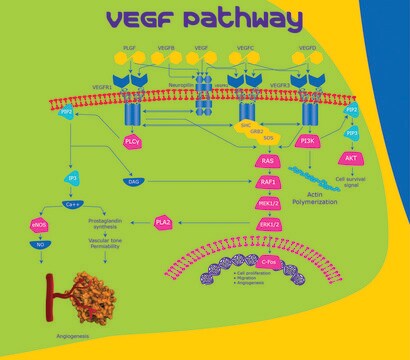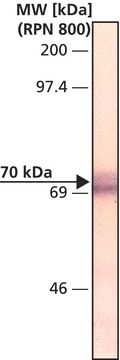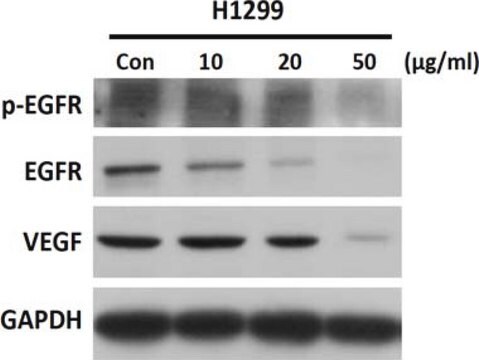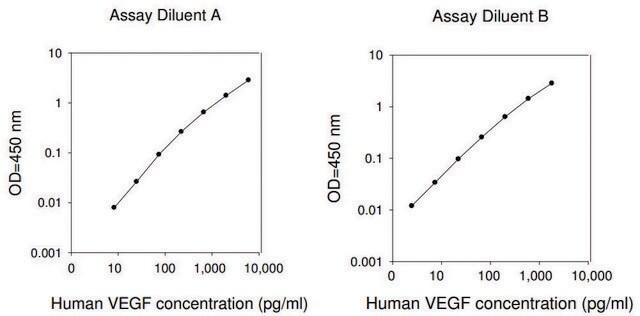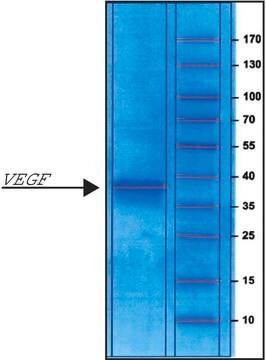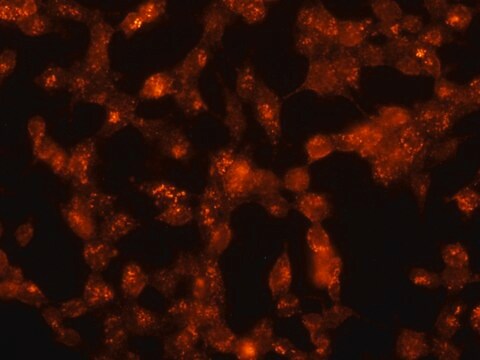V1385
VEGF Receptor-1 (Flt-1)/Fc Chimera human
>90% (SDS-PAGE), recombinant, expressed in baculovirus infected Sf21 cells, lyophilized powder
Sinónimos:
Vascular Endothelial Growth Factor Receptor‑1
Iniciar sesiónpara Ver la Fijación de precios por contrato y de la organización
About This Item
Productos recomendados
origen biológico
human
Nivel de calidad
recombinante
expressed in baculovirus infected Sf21 cells
Ensayo
>90% (SDS-PAGE)
Formulario
lyophilized powder
potencia
≤35 ng/mL ED50
mol peso
predicted mol wt ~100 kDa
envase
pkg of 50 μg
condiciones de almacenamiento
avoid repeated freeze/thaw cycles
impurezas
endotoxin, tested
Nº de acceso UniProt
temp. de almacenamiento
−20°C
Información sobre el gen
human ... FLT1(2321)
Aplicación
VEGF Receptor-1 (Flt-1)/Fc chimera human may be used tostudy vasculogenesis and angiogenesis.
Acciones bioquímicas o fisiológicas
VEGF R1 binds VEGF with high affinity and is a potent VEGF inhibitor.
VEGF Receptor-1 (VEGF R1) also known as Flt-1 belongs to class III subfamily of RTKs and is a potent VEGF antagonist expressed mainly in endothelial cells. VEGF R1 binds to vascular endothelial growth factor B (VEGF-B) and regulates the activity of plasminogen activator in endothelial cells. It also assists endothelial cells in the proper spatial organization of lumen-containing vessels. Additionally, alternatively spliced VEGF R1 pre-mRNA helps in regulating the VEGF activity in angiogenesis. VEGF R1 also activates PLC gamma which in turn produces cellular signaling molecules diacylglycerol as well as inositol 1,4,5-trisphosphate and activates protein kinase C.
VEGF receptors, class III receptor tyrosine kinases, have seven Ig like extracellular motifs and a tyrosine kinase intracellular domain split by a kinase insert sequence. VEGFR 1 was originally called fms like tyrosine kinase 1 (flt 1), indicating its homology to receptors of PDGF, M CSF, and SCF. VEGFR 1 is one of the five receptor tyrosine kinases (KDR/Flk-1, Flt-4, tie-1 and tek/tie-2) whose expression is almost exclusively restricted to endothelial cells. These receptors are likely to play central roles in vasculogenesis and angiogenesis. Recombinant VEGF R1 binds VEGF with high affinity and is a potent VEGF inhibitor. VEGFR 1 and 2 are both expressed in an endothelial cell-specific manner and are detectable in virtually all tissues in adults and embryos. Hypoxia induces endothelial cell expression of VEGFR 1 but not VEGFR 2. Monocytes express VEGFR 1 and 2 and can migrate to the site of VEGF release, but this response appears to be VEGFR 1 mediated. VEGFR 2 is also expressed in pancreatic duct cells. VEGFR 2 is involved in commitment of endothelial-cell lineages and to cell proliferation, while VEGFR 1 seems to be responsible for guiding endothelial cells into the proper spatial organization into lumen-containing vessels. VEGFR 2 is a key marker for pluripotent HSCs. Neurophilins, a group of unrelated receptors for some VEGF family members may also act as coreceptors to facilitate VEGF binding to VEGFR 2. VEGFR 3 is a specific marker for lymphatic vessels. VEGFR 3 has also been detected on some high endothelial venules, in embryonic pre-lymphatic blood vessels, some tumor blood vessels, and certain hematopoietic and leukemia cells.
Forma física
Lyophilized from a 0.2 μm filtered solution in 20 mM MOPS, 500 mM sodium chloride, 0.05% CHAPS, pH 7.0 containing 50 μg bovine serum albumin per 1 μg of cytokine
Nota de análisis
The biological activity is measured by its ability to Inhibit the VEGF-dependent proliferation of human umbilical vein endothelial cells.
Código de clase de almacenamiento
13 - Non Combustible Solids
Clase de riesgo para el agua (WGK)
WGK 3
Punto de inflamabilidad (°F)
Not applicable
Punto de inflamabilidad (°C)
Not applicable
Equipo de protección personal
Eyeshields, Gloves, type N95 (US)
Elija entre una de las versiones más recientes:
¿Ya tiene este producto?
Encuentre la documentación para los productos que ha comprado recientemente en la Biblioteca de documentos.
A Sawano et al.
Biochemical and biophysical research communications, 238(2), 487-491 (1997-09-23)
Flt-1, a tyrosine kinase receptor for vascular endothelial growth factor (VEGF), plays important roles in the angiogenesis required for embryogenesis and in monocyte/macrophage migration. However, the signal transduction of Flt-1 is poorly understood due to its very weak tyrosine kinase
Y He et al.
Molecular endocrinology (Baltimore, Md.), 13(4), 537-545 (1999-04-09)
Angiogenesis is essential for normal mammalian development and is controlled by the local balance of pro- and antiangiogenic factors. Here we describe a novel mouse cDNA sequence encoding sFLT-1 that is a potent antagonist to vascular endothelial growth factor (VEGF)
B Olofsson et al.
Proceedings of the National Academy of Sciences of the United States of America, 95(20), 11709-11714 (1998-09-30)
The vascular endothelial growth factor (VEGF) family has recently expanded by the identification and cloning of three additional members, namely VEGF-B, VEGF-C, and VEGF-D. In this study we demonstrate that VEGF-B binds selectively to VEGF receptor-1/Flt-1. This binding can be
Nuestro equipo de científicos tiene experiencia en todas las áreas de investigación: Ciencias de la vida, Ciencia de los materiales, Síntesis química, Cromatografía, Analítica y muchas otras.
Póngase en contacto con el Servicio técnico